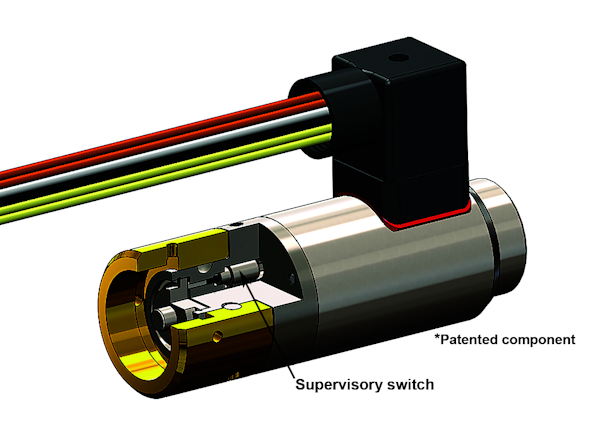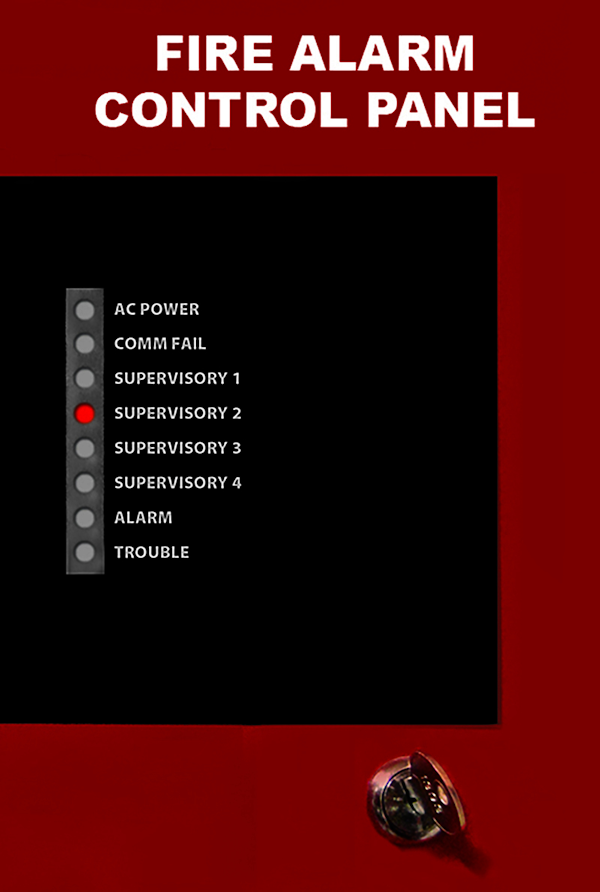Supervision for Releasing Devices on Extinguishing Systems
Extinguishing systems are utilized in a wide array of applications and are configured based on the environment in which they will be used, the system components, and the extinguishing agent employed. Regardless of configuration, the purpose of an extinguishing system is to protect property and personnel. A critical component that helps achieve this is the suppressant releasing device that initiates the mechanical discharge of the extinguishing agent that will combat the fire.
One of the primary releasing devices used on extinguishing systems is a latching solenoid actuator, also referred to as an electric actuator. Typically an electric actuator is attached to the suppressant’s discharge valve and electrically connected to the Fire Alarm Control Panel (FACP). Upon receiving the suppressant release signal, the electric actuator causes the discharge valve(s) to open and dispense the extinguishing agent from the suppressant storage container.
Supervision on extinguishing systems is implemented to monitor various system features and operability of critical devices. Supervision ensures that an electrical connection is present between the remotely located suppressant initiating device (the electric actuator) and the FACP. Additionally, this supervision ensures proper mechanical installation of the suppression system release device. A change in status of the supervisory circuit’s state will signal the extinguishing systems control panel, indicating inoperability of remotely located devices.
Reasons for Action
The position of the releasing device on the discharge valve is a critical system requirement due to the connection controlling the mechanical release of the agent. When the actuator and its position are left unsupervised, opportunities for suppression system failure are introduced. Human installation error is the easiest potential failure mode to identify and already has recorded incidents. The electric actuators are installed on the release valve manually and routinely removed from the extinguishing container for system maintenance and functional testing of the actuator. Without a supervisory signal requirement, a removed electrical connection between the system control panel and actuator does not result in any system alarm conditions. This leaves the responsibility of proper re-installment solely on the technician that removed the actuator with no overall system or secondary operability checks.
Multiple cases have been reported of electric actuators improperly installed by a technician and in some instances left physically unattached altogether. This leaves the system unable to function, creating a dangerous situation if the fire suppressant system is still viewed as operational. The probability of this scenario occurring increases based on the number of people that maintain and inspect the system throughout its useful life.
Most suppressant agent releasing devices are removable components, which raises security concerns with tampering or inadvertent changes in position. Due to an often obstructed view between the mating surfaces of the components, any damage or nonconforming parts impeding proper fit or function could go undetected. Releasing devices also have lengthy intervals between periodic maintenance and inspections allowing for an issue to go unnoticed. If the extinguishing system control panel cannot detect the position of, or changes to the electric actuator, the same suppression system failure as an improper installation occurs. Preventable human errors and problems with solvable engineered solutions are no longer an accepted failure in the technological world of today.
Benefits and Implementation
Figure 1

With the addition of supervision of the electric actuator, the system becomes more robust and reliable, creating an even greater level of protection and security. Potential failures with serious consequences are now identified through the continuous monitoring of a critical system interface. Identified problems alarm the system control panel and can be addressed immediately.
Applying supervision to electrical actuators is a viable and realistic option for both existing and new extinguishing systems. Current systems can typically be retrofitted to include supervisory monitoring as the requirements are already established in many fire protection devices throughout the system. For example, the wire path of the electric actuator and the additional ports on the control panel can accommodate the new supervisory circuit and indicator.
Supervision accommodates industry standards and can easily be integrated with new designs. Incorporating an actuator that is supervised significantly increases the system intelligence pertaining to the overall functionality and usability of the mechanical release of the extinguishing agent. When weighed against the benefits and feasibility to implement, supervision becomes a very cost-effective solution.
Examples
There are a number of different approaches to supervising an electric actuator relative to the discharge valve. One approach is an integrated solution which provides a supervised electric actuator, modeled in figure 1. For this system a normally-closed, push-button switch is secured within a latching solenoid actuator. The switch is wired through the solenoid to the control panel creating a circuit in which the control panel can monitor the solenoid’s position. When the latching solenoid actuator is correctly contacting the discharge valve, the integrated switch is pressed, flipping the switch to an open circuit that is then read by the control panel. The push-button switch provides the supervisory contact while the control panel monitors the signal.
Other approaches for achieving supervision on the electric actuator include external sensors on the actuator, sensors on the valve, and an intermediate type component located between the valve and actuator.
Codes & Standards

Extinguishing systems must abide by the codes and standards that govern their products and area of installation. The National Fire Protection Association (NFPA) will be one of the first governing bodies to require supervision of electric actuators. NFPA 2001: Sec. 4.3.4.1, 4.3.4.2 effective January 1, 2016.
“Removal of an electric actuator from the agent storage container discharge (4.3.4.2 selector) valve that it controls shall result in an audible and visual indication of system impairment at the system releasing control panel.” **Reproduced with permission from NFPA 2001- 2015 Standard on Clean Agent Fire Extinguishing Systems, copyright © 2015 NFPA
Globally there are many different associations and governing bodies that dictate what codes and standards the manufactures and owners of extinguishing systems must comply with in their governed area. Extinguishing systems can go above and beyond what is required by code but ultimately it is the governing bodies that drive industry changes and new building requirements within their respective regions. Supervisory signals will require new standards and codes for the various governing bodies to further advance the safety and reliability of extinguishing systems.
Future Applications
Extinguishing systems and their components continue to evolve and advance every year; with the capabilities of supervisory signals being one of the most promising. Supervised electronic actuators alert the system when critical components are not interfacing and functioning properly, allowing technicians to address problems before they pose a serious hazard. The same supervisory signal can be applied to pneumatic actuators to combat the potential failures of additional extinguishing agent releasing devices. Beyond actuators, many additional components and features throughout the fire protection system could be monitored and communicate the status back to the control panel. Supervision could also be used to monitor the presence of commonly removed or serviced parts. The many applications for supervision will grow and change alongside the system and components they are monitoring. With the significant benefits and risk reduction, it is likely that future designs and standards will continue to incorporate supervisory type signals.
This article was originally published by International Fire Protection in December 2015
Want to explore design examples?
TLX Technologies is the go-to custom solenoid partner of the world’s top brands, first-tier suppliers, and OEMs